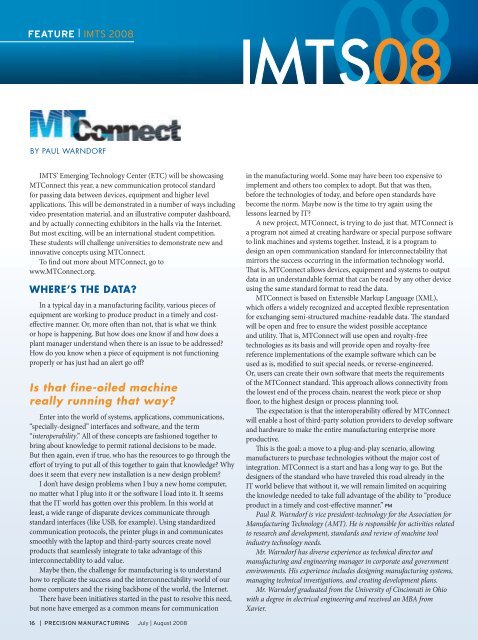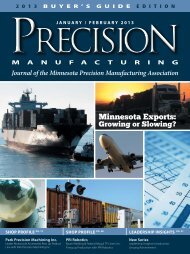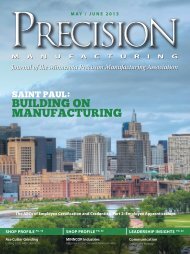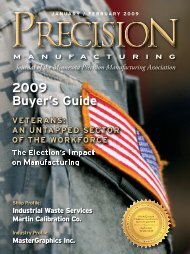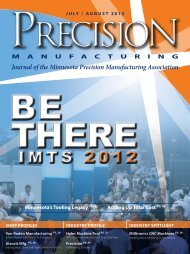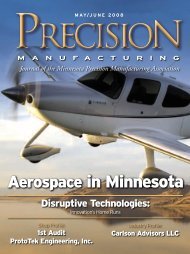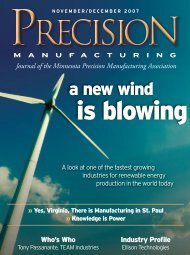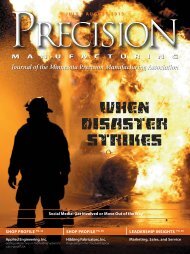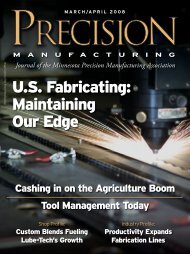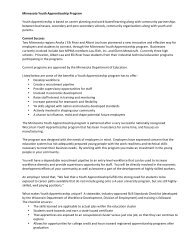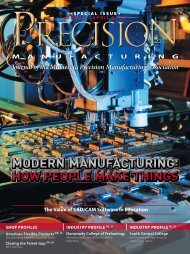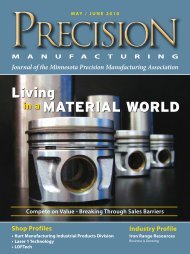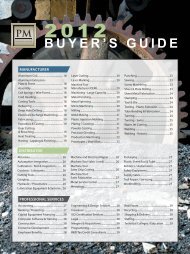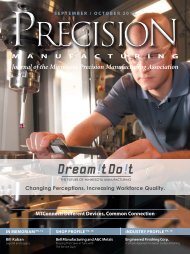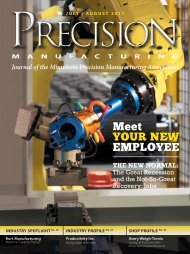July / August - Minnesota Precision Manufacturing Association
July / August - Minnesota Precision Manufacturing Association
July / August - Minnesota Precision Manufacturing Association
Create successful ePaper yourself
Turn your PDF publications into a flip-book with our unique Google optimized e-Paper software.
BY PAUL WARNDORF<br />
IMTS’ Emerging Technology Center (ETC) will be showcasing<br />
MTConnect this year, a new communication protocol standard<br />
for passing data between devices, equipment and higher level<br />
applications. This will be demonstrated in a number of ways including<br />
video presentation material, and an illustrative computer dashboard,<br />
and by actually connecting exhibitors in the halls via the Internet.<br />
But most exciting, will be an international student competition.<br />
These students will challenge universities to demonstrate new and<br />
innovative concepts using MTConnect.<br />
To find out more about MTConnect, go to<br />
www.MTConnect.org.<br />
WHERE’S THE DATA?<br />
In a typical day in a manufacturing facility, various pieces of<br />
equipment are working to produce product in a timely and costeffective<br />
manner. Or, more often than not, that is what we think<br />
or hope is happening. But how does one know if and how does a<br />
plant manager understand when there is an issue to be addressed?<br />
How do you know when a piece of equipment is not functioning<br />
properly or has just had an alert go off?<br />
Is that fine-oiled machine<br />
really running that way?<br />
Enter into the world of systems, applications, communications,<br />
“specially-designed” interfaces and software, and the term<br />
“interoperability.” All of these concepts are fashioned together to<br />
bring about knowledge to permit rational decisions to be made.<br />
But then again, even if true, who has the resources to go through the<br />
effort of trying to put all of this together to gain that knowledge? Why<br />
does it seem that every new installation is a new design problem?<br />
I don’t have design problems when I buy a new home computer,<br />
no matter what I plug into it or the software I load into it. It seems<br />
that the IT world has gotten over this problem. In this world at<br />
least, a wide range of disparate devices communicate through<br />
standard interfaces (like USB, for example). Using standardized<br />
communication protocols, the printer plugs in and communicates<br />
smoothly with the laptop and third-party sources create novel<br />
products that seamlessly integrate to take advantage of this<br />
interconnectability to add value.<br />
Maybe then, the challenge for manufacturing is to understand<br />
how to replicate the success and the interconnectability world of our<br />
home computers and the rising backbone of the world, the Internet.<br />
There have been initiatives started in the past to resolve this need,<br />
but none have emerged as a common means for communication<br />
in the manufacturing world. Some may have been too expensive to<br />
implement and others too complex to adopt. But that was then,<br />
before the technologies of today, and before open standards have<br />
become the norm. Maybe now is the time to try again using the<br />
lessons learned by IT?<br />
A new project, MTConnect, is trying to do just that. MTConnect is<br />
a program not aimed at creating hardware or special purpose software<br />
to link machines and systems together. Instead, it is a program to<br />
design an open communication standard for interconnectability that<br />
mirrors the success occurring in the information technology world.<br />
That is, MTConnect allows devices, equipment and systems to output<br />
data in an understandable format that can be read by any other device<br />
using the same standard format to read the data.<br />
MTConnect is based on Extensible Markup Language (XML),<br />
which offers a widely recognized and accepted flexible representation<br />
for exchanging semi-structured machine-readable data. The standard<br />
will be open and free to ensure the widest possible acceptance<br />
and utility. That is, MTConnect will use open and royalty-free<br />
technologies as its basis and will provide open and royalty-free<br />
reference implementations of the example software which can be<br />
used as is, modified to suit special needs, or reverse-engineered.<br />
Or, users can create their own software that meets the requirements<br />
of the MTConnect standard. This approach allows connectivity from<br />
the lowest end of the process chain, nearest the work piece or shop<br />
floor, to the highest design or process planning tool.<br />
The expectation is that the interoperability offered by MTConnect<br />
will enable a host of third-party solution providers to develop software<br />
and hardware to make the entire manufacturing enterprise more<br />
productive.<br />
This is the goal: a move to a plug-and-play scenario, allowing<br />
manufacturers to purchase technologies without the major cost of<br />
integration. MTConnect is a start and has a long way to go. But the<br />
designers of the standard who have traveled this road already in the<br />
IT world believe that without it, we will remain limited on acquiring<br />
the knowledge needed to take full advantage of the ability to “produce<br />
product in a timely and cost-effective manner.” PM<br />
Paul R. Warndorf is vice president-technology for the <strong>Association</strong> for<br />
<strong>Manufacturing</strong> Technology (AMT). He is responsible for activities related<br />
to research and development, standards and review of machine tool<br />
industry technology needs.<br />
Mr. Warndorf has diverse experience as technical director and<br />
manufacturing and engineering manager in corporate and government<br />
environments. His experience includes designing manufacturing systems,<br />
managing technical investigations, and creating development plans.<br />
Mr. Warndorf graduated from the University of Cincinnati in Ohio<br />
with a degree in electrical engineering and received an MBA from<br />
Xavier.


